If you want to know about the introduction of pile foundation or types of concrete and its uses or concrete mix design, please click the link.
Brick masonry is a construction technique that involves using bricks and mortar to create walls, buildings, and other structures.
The bricks are arranged in specific patterns and held together with mortar, which is a mixture of cement, sand, and water. Brick masonry is durable, fire-resistant, and has good thermal insulation properties, making it a popular choice for building construction.
- The definition of brick masonry is the placing of bricks on the mortar in a systematic manner to create a structure that sustains the exerted load.
- The term masonry indicates the art of building structures in either brickwork or stonework.
- The masonry work in itself is the most important traditional technology, even if there are a lot of new materials of construction are adopted.
- The uses of brick masonry in the construction of foundations, walls, columns, and other similar structures.
1) Technical terms used in brick masonry
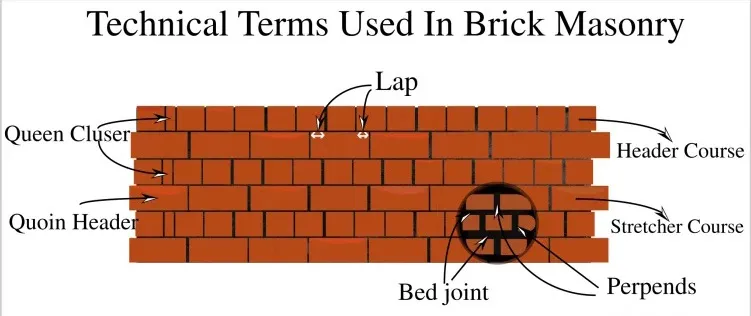
Here are the lists of the technical terms, which is used in brick masonry.
- Course
- Stretcher
- Stretcher Course
- Header
- Arrises
- Bed
- Bed Joint
- Perpends
- Laps
- Closer
- Bat
- Bullnose
- Cownose
- Squint Quoint
- Frog
- Racking Back
- Toothing
- Quoins
i) Course
- In brick masonry or in stone masonry the course is the horizontal layer of bricks of stones.
ii) Stretcher
- In the brick masonry, the stretcher is the longest side of the brick which is put parallel to the face of the work.
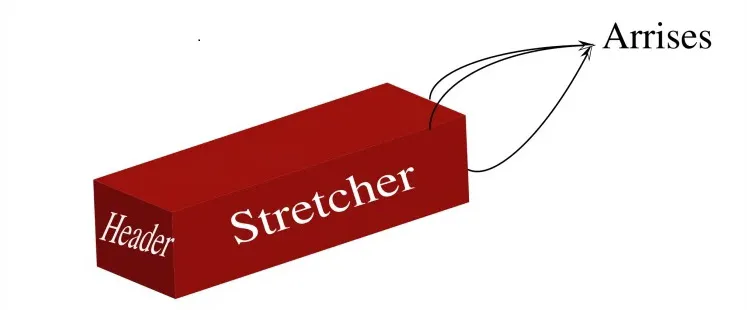
- A brick which is laid in a way that allows only the longer side of the brick to be exposed.
iii) Stretcher Course
- In the brick masonry work, the course containing the stretcher is known as the stretcher course.

iv) Header
- The header is a brick that is put with its width parallel to the face or direction of the wall.
- The course which is containing headers is called a header course.
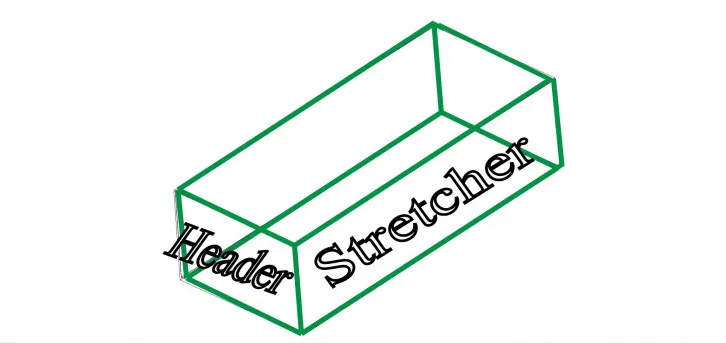
- A brick which is laid in a way that only the short end is visible in the wall

v) Arrises
- In the brick, arrises are the point where the plane surfaces of the bricks intersect with each other.

vi) Bed
- The bed indicates the lower part of brick in each layer when the brick is put on the course.
vii) Bed Joint
- In the brick masonry, the bed joint is the horizontal layer of mortar where the brick is going to be put.
viii) Lap
- Lap in the brick masonry is defined as the horizontal distance between the vertical joints of successive courses.
- For a good bond between the brick and the mortar, the lap should be one-fourth of the length of a brick.
ix) Perpends
- Perpends in the brick masonry are the vertical joints that separate the bricks either in length or cross direction wise.
- In brick masonry work, for achieving a good bond, the perpends in the alternate courses or horizontal layers should be below each other.
x) Closer
- In the brick masonry work, closer is a piece of brick that is prepared by a mason with the edge of the trowel.
- The closer is used to close up the bond at the end of the brick course.
- Closer in the brick masonry is further divided into the following four parts:
- Queen Closer in Brick Masonry
- King Closer in Brick Masonry
- Bevelled Closer in Brick Masonry
- Mitred Closer in Brick Masonry
Queen Closer in Brick Masonry
- We can easily obtain the queen closer by cutting the different types of bricks longitudinally in two equal parts.
- Without wasting the quarter bricks, we can also obtain the queen closer by adding the two-quarter bricks.
- The queen closer is used near the quoin header to obtain the necessary lap.
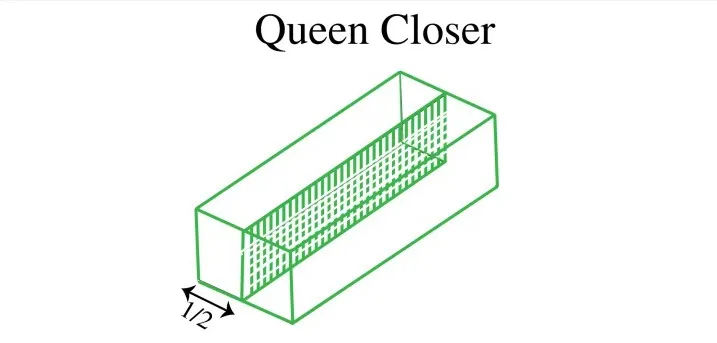
King Closer in Brick Masonry
- King closer is made by cutting a triangular portion from the brick.
- The triangular portion must include the half header and half stretcher while cutting the brick on the adjoining faces.
- The king closer is used near the windows and doors openings for the proper arrangement of the mortar joint.
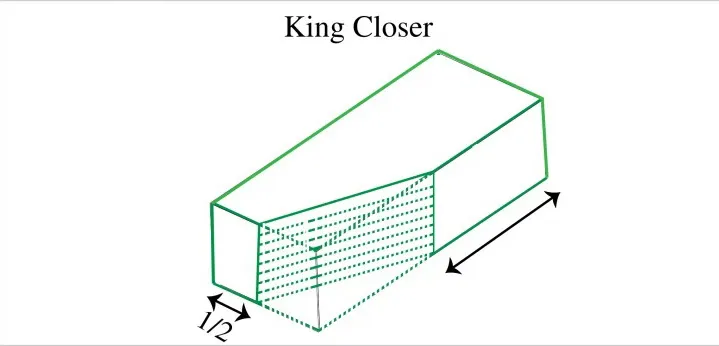
Bevelled Closer in Brick Masonry
- Bevelled closer is made by cutting a triangular portion from the brick.
- The triangular portion must include the full length and half-width of the brick. The bevelled closer is used in the splayed brickwork.
- When we see the bevelled closer its looks closer on one face and header at the other face.
Mitred Closer in Brick Masonry
- Mitred closer is made by cutting a triangular portion from the brick.
- The triangular portion must include the full width and making an angle of 45 degrees to 60 degrees with the length of the brick.
- Mitred closers are used at corners and junctions.
xi) Bat
- Bat is defined as a broken piece of bricks, and it is related to the length of a brick.
- Related to the length, bats are commonly three types, the first is the Half Bat, the second is the Three-Quarter Bat, and the last one is Bevelled Bat.
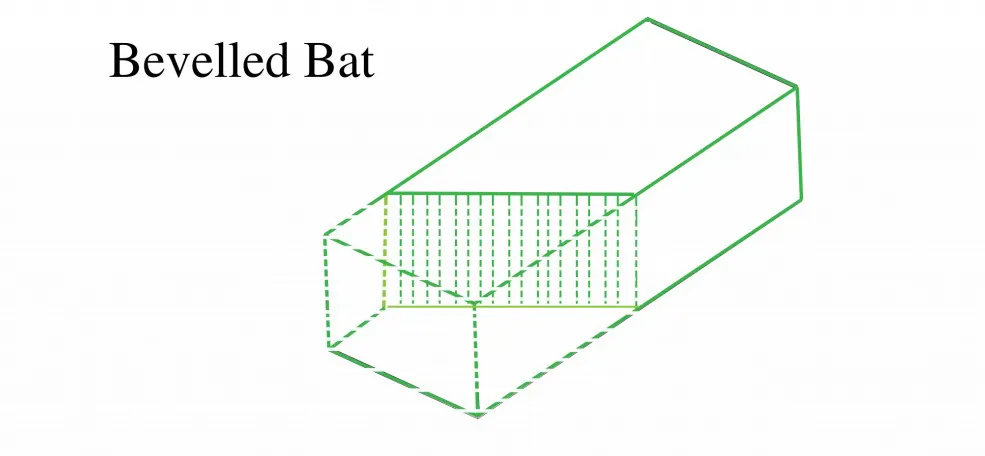
xii) Bullnose
- A brick that is molded with a rounded angle is termed a bullnose. Bullnose is used for the rounded quoin.

xiii) Cownose
- Double bullnose brick is known as cownose.

xiv) Squint Quoin
- When a brick is cut or moulded in such a way that the cut or moulded brick makes an angle other than 90 degrees in the plane is known as squint quoin.
xv) Toothing
- Toothing in the construction is a process of providing the extension of bricks in the alternate courses.
- The toothing is provided to better connect the wall, when the wall is continued in the future.
xvi) Frog
- The frog on the brick is a depth on the face of the brick, that is provided for the better holding the mortar with the bricks.
- The depth of the frog on the brick is about 10 mm to 20 mm.
- The number of the frogs on the bricks is varied on the basis of bricks like wire cut bricks have no frog, handmade bricks have one frog, and pressed brick has two frogs.
xvii) Racking Back
- In brick masonry, the termination of the wall in a stepped manner is known as the racking back.
xviii) Quoins
- In brick masonry, the external corners or angles of a wall surface are called quoins.
2) Types of Brick Masonry
- Types of brickwork depend on many factors like what is the quality of mortar, the quality of bricks, and many more factors.
Brickwork is classified into mainly two parts
- Brick Work in Mud
- Brick Work in Cement
i) Brickwork In Mud
- When we use mud to fill the joints in brickwork, then this type of brickwork is known as brickwork in mud.
- The mud mortar is prepared by mixing the clay, soil with water.
- The main uses of mud mortar for the cheapest constructions in the village area and the thickness of the mud mortar joint are 12 mm.
- The main advantage of mud mortar is, it is the cheapest mortar for construction, and it is eco-friendly.
- The main disadvantage of mud mortar is it has no high strength so it cannot sustain the load of multi-stored buildings.
ii) Brickwork In Cement
- When we use cement mortar to fill the joints in brickwork, then this type of brickwork is known as brickwork in cement.
The cement mortar brickwork is furder divided into three parts
- First Class Cement Brickwork
- Second Class Cement Brickwork
- Third Class Cement Brickwork
First Class Cement Brickwork
- In the first-class cement brickwork, the table molded and burnt in kilns bricks are used which means the brick must be standard brick.
- The thickness of the mortar joint in first-class cement brickwork does not exceed 10 mm.
Second Class Cement Brickwork
- In the second class of cement brickwork, the ground-molded bricks and it also burnt in kilns are used which have a slightly irregular shape, some cracks on them, and not a sharp edge.
- The thickness of the second-class cement mortar joints is 12 mm.
Third Class Cement Brickwork
- The third-class cement mortar brickwork is similar to the second-class cement brickwork, but the main difference is the brick that is going to use in third class cement brickwork is burnt in clamps.
3) Mud Mortar Vs Cement Mortar
| Mud Mortar | Cement Mortar | |
| 1. | Mud mortar does not have high strength. | Cement mortar does have high strength. |
| 2. | Mud mortar is the cheapest mortar. | Cement mortar is expensive than mud mortar. |
| 3. | Mud mortar is locally available. | Cement mortar is not locally available. |
| 4. | Mud Mortar is eco-friendly. | Cement mortar is not eco-friendly. |
| 5. | Mud mortar is not used for the multi stored building. | Cement mortar is used for the multi stored building. |
4) Defects in Brick Masonry
The brick masonry may develop defects mainly for four reasons:
- Sulphate Attack: Sulphate react with alumina of cement which lead to increase the volume of mortar.
- Shrinkage on Drying: Due to atmospheric heat, water evaporates, and brickwork shrinks.
- Crystallization of Salts from Bricks: These defects are known as efflorescence.
- Corrosion of Embedded Fixtures: The iron or steel fixtures may get corroded in presence of dampness
Brick masonry can be done using different types of bricks, such as clay bricks, concrete bricks, or stone bricks, each with their own unique properties and aesthetic appeal. The skill of a brick mason is critical to ensuring the quality and durability of the finished structure.